How to Prepare Your UTV for a Desert Trail Adventure: Essential Tips and Maintenance Checks
How to Prepare Your UTV for a Desert Trail Adventure: Essential Tips and Maintenance Checks
Embarking on a desert trail adventure requires thorough preparation to ensure a safe and enjoyable experience. Our UTVs need to be in top condition to handle the rugged terrain and challenging conditions that come with desert exploration. This means going beyond the basic pre-ride checkup; it involves a meticulous review of all mechanical components, including the engine, suspension, and cooling systems. Completing a detailed inspection and addressing any potential issues beforehand can markedly reduce the risk of breakdowns in remote areas.
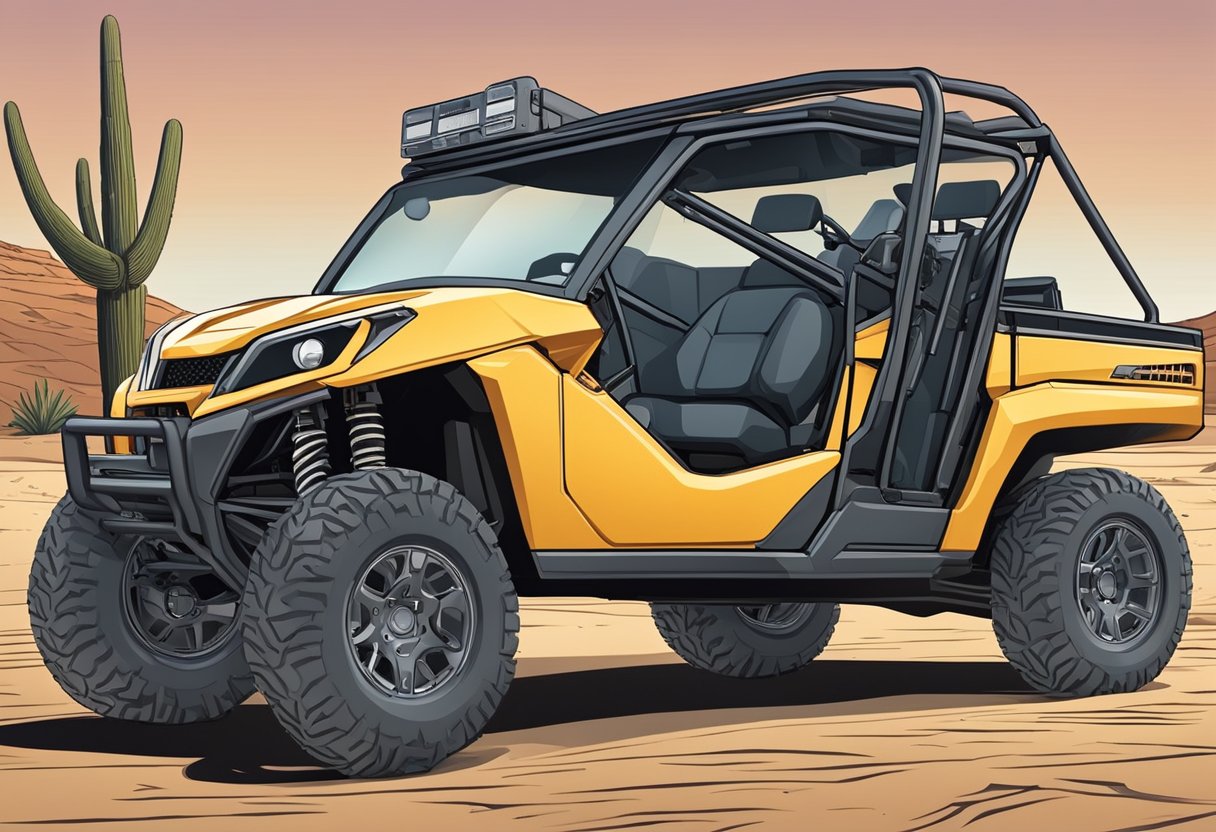
Before setting out, we must also plan for the unique environmental factors of the desert. From the intense heat and glare to the abrasive sand, every aspect of the desert can affect both our vehicles and us. Properly outfitting our UTVs with items essential for desert terrain, such as tire plug kits or air compressors, is just as crucial as bringing personal protective gear to shield ourselves from the sun and heat.
Complete UTV Tire Repair Kit

In addition to mechanical readiness and personal safety gear, our planning process should incorporate route selection, knowledge of the local climate patterns, and an understanding of the navigational challenges we may face. Preparing for a desert adventure also means equipping ourselves with the necessary survival skills and gear, such as a fire extinguisher for the unexpected. It's our attention to detail in the preparation and planning stages that paves the way for a successful and memorable desert odyssey.
Understanding the Desert Environment
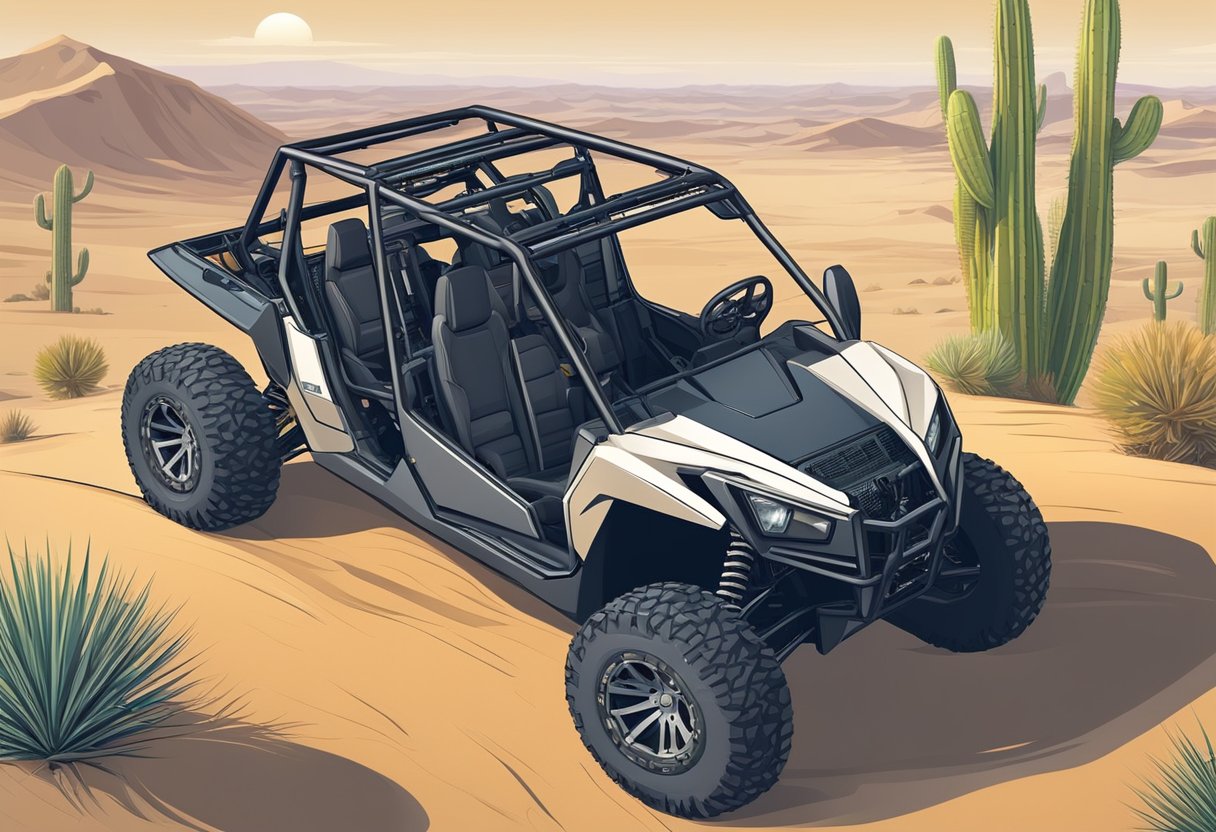
Before we embark on an adventure through desert trails with our UTVs, it's crucial to grasp the unique elements of the desert environment. From the shifting climate to the challenging terrain, and the distinct flora and fauna, awareness is our ally in these expansive landscapes.
Climate Characteristics
The climate in deserts is marked by extreme temperatures and dry conditions. During the day, the mercury can soar, but once the sun dips, temperatures can plunge dramatically. This lack of clouds generally means that deserts have more open spaces under high-pressure systems, contributing to the temperature variance.
- Daytime temperatures can exceed 100°F (38°C), especially in locations like Death Valley.
- Nighttime temperatures can drop significantly, making layered clothing a necessity.
Winds can also pick up suddenly and vary in intensity. Keeping a weather forecast handy helps us prepare for sudden changes that could affect visibility and driving conditions.
Terrain and Navigation
Navigating through a desert requires a reliable compass, updated GPS, and a map of the area. The terrain can vary from barren deserts to rocky outcroppings.
- Desert trails, like those found in Arizona, present open spaces that can be deceptively vast.
- Sand dunes and unpredictable ground conditions call for heightened awareness and appropriate tires.
Using technology in combination with traditional navigation skills ensures that we remain oriented and on the correct trail.
Flora and Fauna
Desert life is robust and has uniquely adapted to the extreme conditions. Common cactus varieties like the Saguaro are iconic to deserts like Arizona, while the fauna include resilient species that have evolved to conserve water and avoid the heat.
- Flora such as creosote bushes, yuccas, and various cacti can provide minimal shade but are vital life sources in the ecosystem.
- Fauna, including reptiles, birds, and mammals, tend to be most active during cooler periods such as dusk and dawn.
Respecting the desert means preserving the delicate balance that allows these life forms to thrive amid a lack of water and nourishment.
Essential UTV Preparations

In preparing for a desert trail adventure, it's crucial to focus on vehicle maintenance and terrain-specific upgrades. This ensures that our UTV is equipped to handle the unique challenges of desert environments.
Vehicle Maintenance
Fluid Checks and Changes: We start by thoroughly checking and changing all fluids. We ensure the coolant is filled to the appropriate level and swap it out for fresh fluid to prevent our engine from overheating. Similarly, engine oil quality can significantly affect performance; therefore, we replace it with a high-grade option suitable for high temperatures.
Battery and Alternator: The battery must be fully charged to avoid being stranded in remote areas. We also inspect the alternator's functioning to guarantee our UTV's charging system won't fail when we need it most.
Radiator Inspection: Desert heat puts extra strain on the cooling system. We inspect the radiator for any signs of damage or blockage that could impede its effectiveness.
| Maintenance Checklist | Status |
|---|---|
| Check coolant level | [ ] |
| Change oil | [ ] |
| Fully charge battery | [ ] |
| Test alternator output | [ ] |
| Radiator functionality | [ ] |
Upgrading for Desert Terrain
Tire Selection: Equipping our UTV with the right tires is paramount for desert trails. We opt for tires that offer enhanced grip and are made to withstand the puncture-prone surfaces of the desert.
Spare Tire: It's essential to carry a spare tire because flat tires are a common issue on rough terrain. We secure our spare tire in an easily accessible spot.
| Terrain Upgrades | Considerations |
|---|---|
| Tire Type | High grip, puncture-resistant |
| Spare Tire Position | Easily accessible for quick changes |
By adhering to these specific preparation steps, we ensure our UTV is ready to face the adventure ahead with confidence and reliability.
Packing the Right Gear
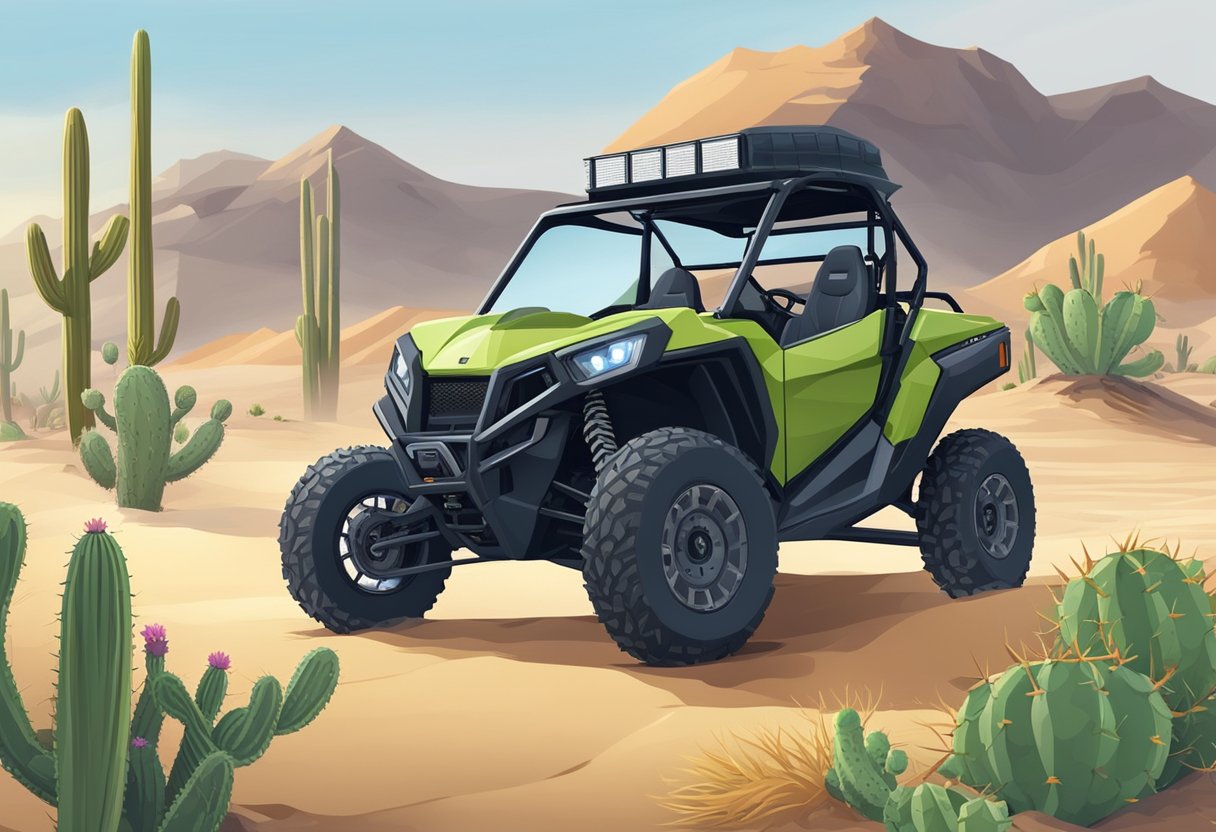
In a desert trail adventure, it's essential that we carry the right equipment to navigate the challenging terrain, ensure our safety, and maintain comfort under harsh conditions.
Navigation Tools
Navigating the unforgiving desert terrain requires precise and dependable tools. We always include a traditional Compass and detailed Map of the area as fail-safes, even if we primarily rely on a GPS device for real-time location tracking. Additionally, in our kit, a Weather Radio is crucial to stay informed on potential storms or extreme weather changes.
Survival and Safety Equipment
In our preparation for the uncertainties of the desert, our safety gear is non-negotiable. Key items include:
- First Aid Kit: Stocked with bandages, antiseptic wipes, and splints.
- Sunscreen and Bug Spray: To protect our skin from the sun's harsh rays and deter insects.
- Fresh Food and plenty of Water: Critical for maintaining our energy and hydration.
First Aid Kit
Comfort and Protection Items
Our comfort in the desert is just as important as our safety. Here's what we pack:
- Helmet and Goggles: Essential for protecting our head and eyes from flying debris.
- Clothing and Footwear: Lightweight, breathable, but durable to shield us from the sun and heat.
- Tent and Tarp: For necessary shelter during prolonged outings.
- Sunglasses: To guard our eyes against glare and UV exposure.
Personal Safety and Comfort
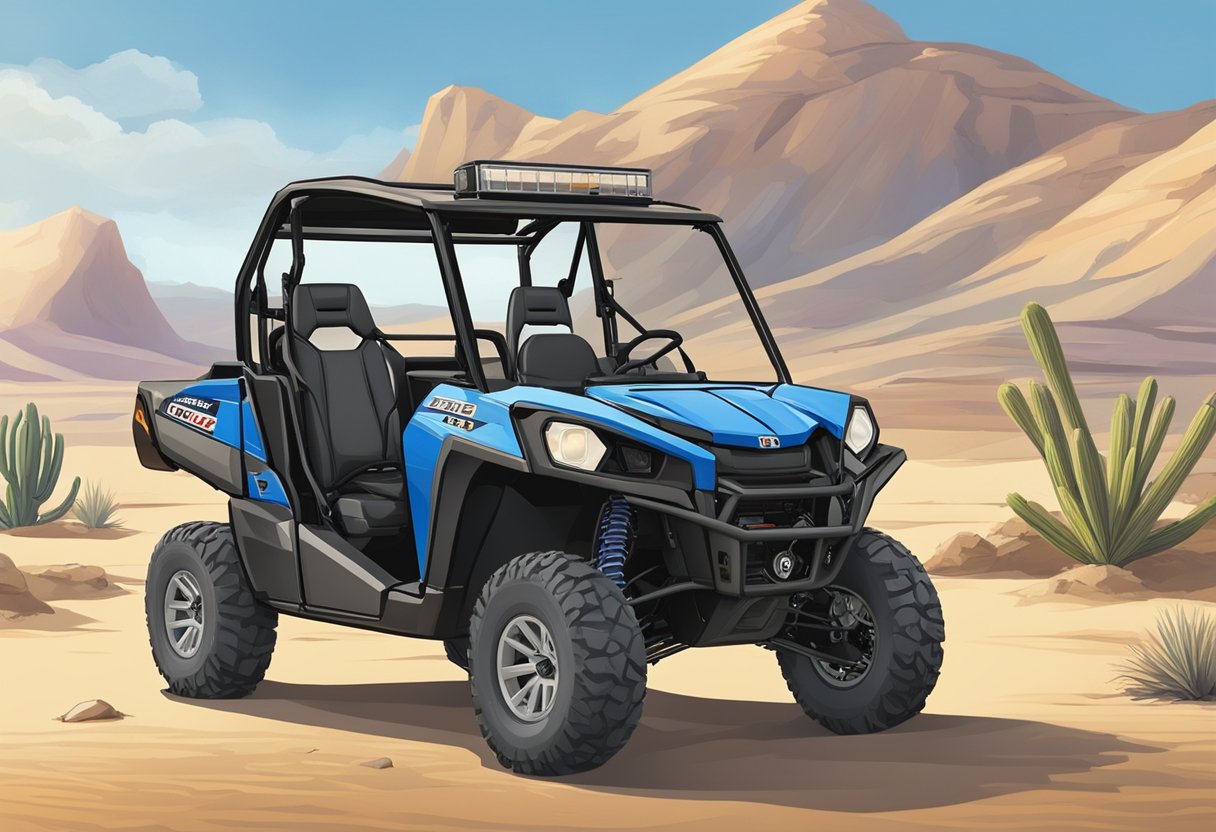
When strapping in for a desert trail adventure, we prioritize two critical aspects for an enjoyable experience: personal safety and comfort. These form the foundation of our preparation and directly influence our endurance and protection against harsh desert conditions.
Appropriate Clothing
Summer Gear: For summer rides, we opt for long pants and shirts made from a cotton variety or a blend of nylon and spandex, which provide breathability and move moisture away from the body. A wide-brimmed hat is essential for shade, while light colors like khaki reflect sunlight, helping to keep us cooler than dark shades would. In many states, wearing a helmet is a mandatory safety measure, which can make a warm journey even more uncomfortable. We strongly advise investing in a UTV Fresh Air Pumper system to facilitate airflow through your helmet. This system serves a dual purpose: it not only prevents dust from entering your respiratory system but also helps to maintain a cooler temperature for your head.
- Head and Hands: Sunglasses protect our eyes, while durable gloves safeguard our hands from blisters and cuts.
- Footwear: We favor sturdy boots to support and shield our feet from rough terrain and potential snake bites.
- Helmet: We carry a wide variety of fresh air helmets and pumper systems to Keep your head cool!
Winter Prep: As temperatures drop, layering becomes vital. We start with moisture-wicking underwear, such as boxer-briefs, and add insulated layers that can be removed as needed throughout the day. Keeping our core warm is key to comfort and safety during colder desert outings.
Hydration and Nutrition
Hydration is non-negotiable. We always pack ample water—at least one gallon per person per day—to prevent dehydration.
- Water Storage: Hydration packs are preferred for their convenience and capacity. Alternatively, we carry insulated water bottles that keep water cool throughout the day.
A balanced selection of food provides the energy needed to maintain stamina on the trails.
- Snacks: We include high-energy, nutrient-dense snacks; think trail mix, energy bars, and fresh fruits. For longer rides, a meal rich in protein and complex carbohydrates is included to ensure sustained energy levels.
By carefully considering our attire and consumables, we can tackle the challenges of the desert with confidence, keeping our focus on the adventure ahead.
Safe Riding Practices
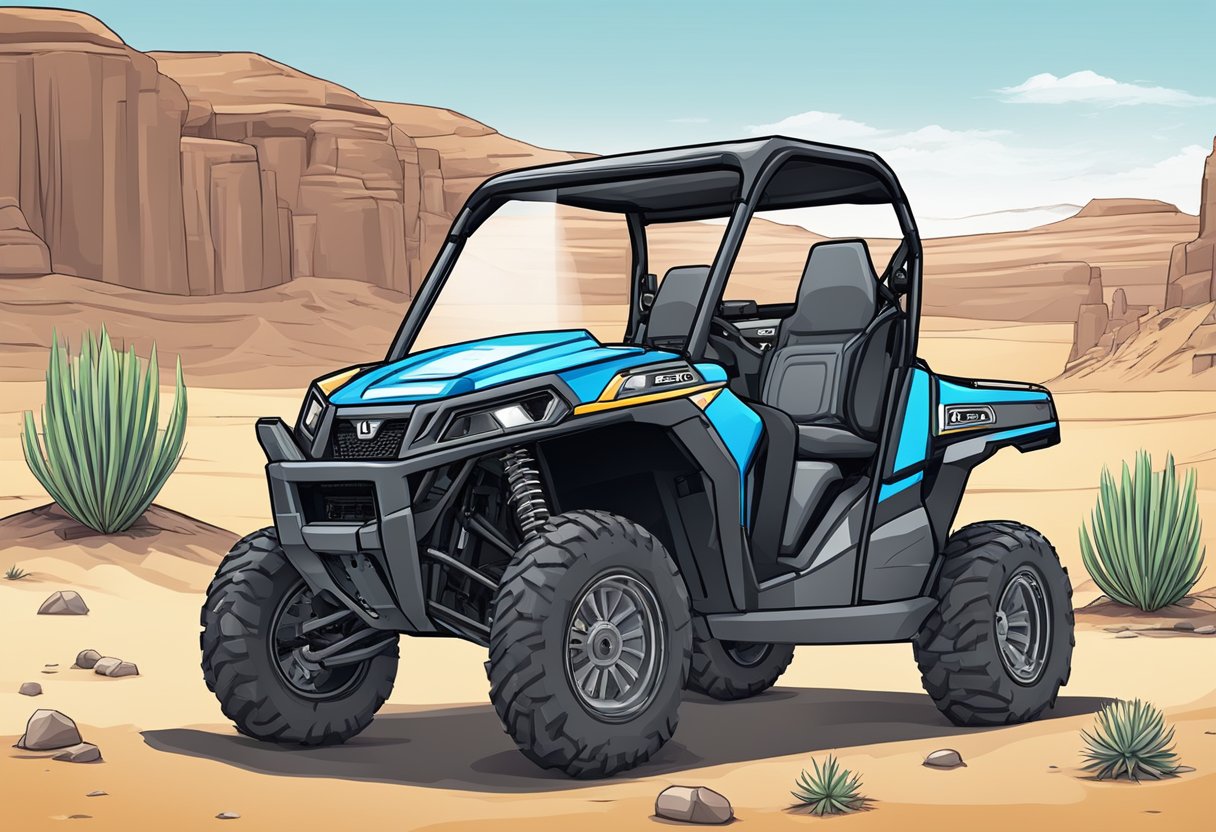
Before we hit the desert trails, it's essential we understand and implement safe riding practices. Not only will these practices keep us secure, but they will also enhance our overall trail experience in the rugged terrain.
Desert Driving Techniques
When driving in the desert, we must adjust our techniques to navigate the unique challenges presented by sandy and often unpredictable terrain. First, we maintain a good grip on the steering to handle the loose surface; low tire pressure can help with this. It's crucial we estimate travel times wisely to avoid the intense midday heat that can lead to an overheating engine. In technical areas, we reduce speed and approach obstacles at a slight angle to prevent tires from getting buried in the sand. Throughout our journey, it's important to constantly research and be aware of potential hazards such as sudden drops, rocks, or unstable ground.
Emergency Preparedness
On any desert adventure, being prepared for emergencies is non-negotiable. We always perform a thorough weather check before departing to avoid being caught in dangerous conditions. Our UTV is equipped with essential spare parts including an extra tire, tie rods, ball joints, axles, and a drive belt, ensuring we can handle common breakdowns on site. We make sure our contact numbers for local rescue services are accessible, and we carry a reliable communication device that works off the cellular grid. Bringing ample water and a first aid kit is also part of our standard procedure. By preparing for the worst, we can enjoy our adventure with peace of mind.
Leaving No Trace
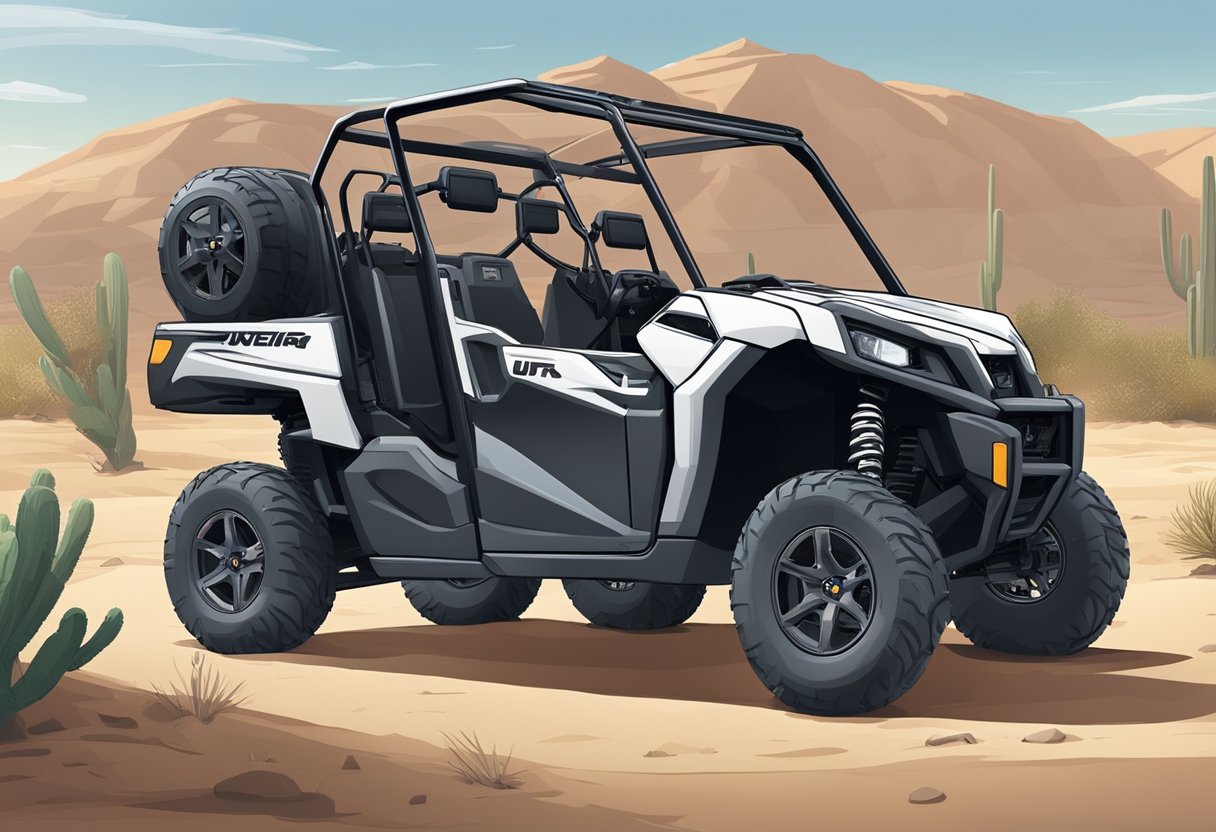
When we embark on a desert trail adventure with our UTV, we must prioritize leaving no trace to preserve the beauty of the environment and protect the flora and fauna. Here's how we do it:
Environmental Responsibility
On any desert adventure, it's our duty to minimize our footprint. We respect the hostile environments where the balance of nature is delicate. Here are key practices we follow:
- Stay on Designated Paths: This prevents damage to sensitive desert habitats.
- Respect Wildlife: We observe from a distance and never feed or disturb the animals.
- Minimize Campfire Impact: In areas where fires are permitted, we use existing fire rings and burn only small logs that we're confident will be fully consumed.
Waste Management
Proper waste disposal is crucial to protect the environment and ensure others can enjoy the same pristine desert landscapes. Here are our strategies:
- Pack It In, Pack It Out: All garbage, including food scraps, must leave with us.
- Sanitation: We use portable toilets or dig cat holes (6 to 8 inches deep) at least 200 feet away from any water source, campsites, or trails.
- Litter Pickup: We always carry out not only our own waste but any litter we come across on our journey.
Frequently Asked Questions

In this section, we explore some of the most crucial queries about gearing up for a UTV desert trail adventure. We offer advice on the essential gear, mechanical preparation, safety, navigation, trail differences, and proper etiquette.
What essential gear should you carry for a UTV desert trail outing?
For any desert trail excursion, it's vital to have good tires specifically designed for sand, such as sand paddle tires that enhance traction. Also, carry a robust safety kit that includes a spare tire, air compressor, tire plug kit, and a set of basic tools.
How do you ensure your UTV is mechanically prepared for trail challenges?
Performing a thorough check of your UTV's fluid levels, tire pressure, and ensuring that all moving parts are properly lubricated is essential. Ensure your UTV's mechanical readiness includes a functional cooling system and that the air filter is clean to handle the fine desert sand.
What safety equipment is mandatory for desert UTV riding?
A roll cage to protect against rollovers, a safety flag—at least 8 feet from the ground—for visibility, and helmets are non-negotiable safety must-haves. Also, carry an adequate fire extinguisher, first-aid kit, and a reliable communication device.
How can you effectively navigate trails during a desert adventure?
Devices equipped with GPS and physical maps are indispensable for desert navigation. Familiarize yourself with the trails beforehand and always let someone know your planned route. Plan your stops for rest and checks on your UTV's condition.
What are the key differences in preparation between desert and forest UTV rides?
Desert rides demand preparation for extreme temperatures and sandy terrain. Cooling systems must be in top condition, and protection from the sun is essential. On forest trails, you’ll focus more on maneuvering through tight spaces and navigating over fallen debris and varying soil conditions.
How should you handle trail etiquette when encountering other riders?
Maintain a respectful distance, signal your intentions, and pass with caution, ensuring the other riders are aware of your presence. Shared trails mean mutual respect; so, communicate effectively, minimize dust for riders behind you, and follow the local guidelines for right of way and speed.


